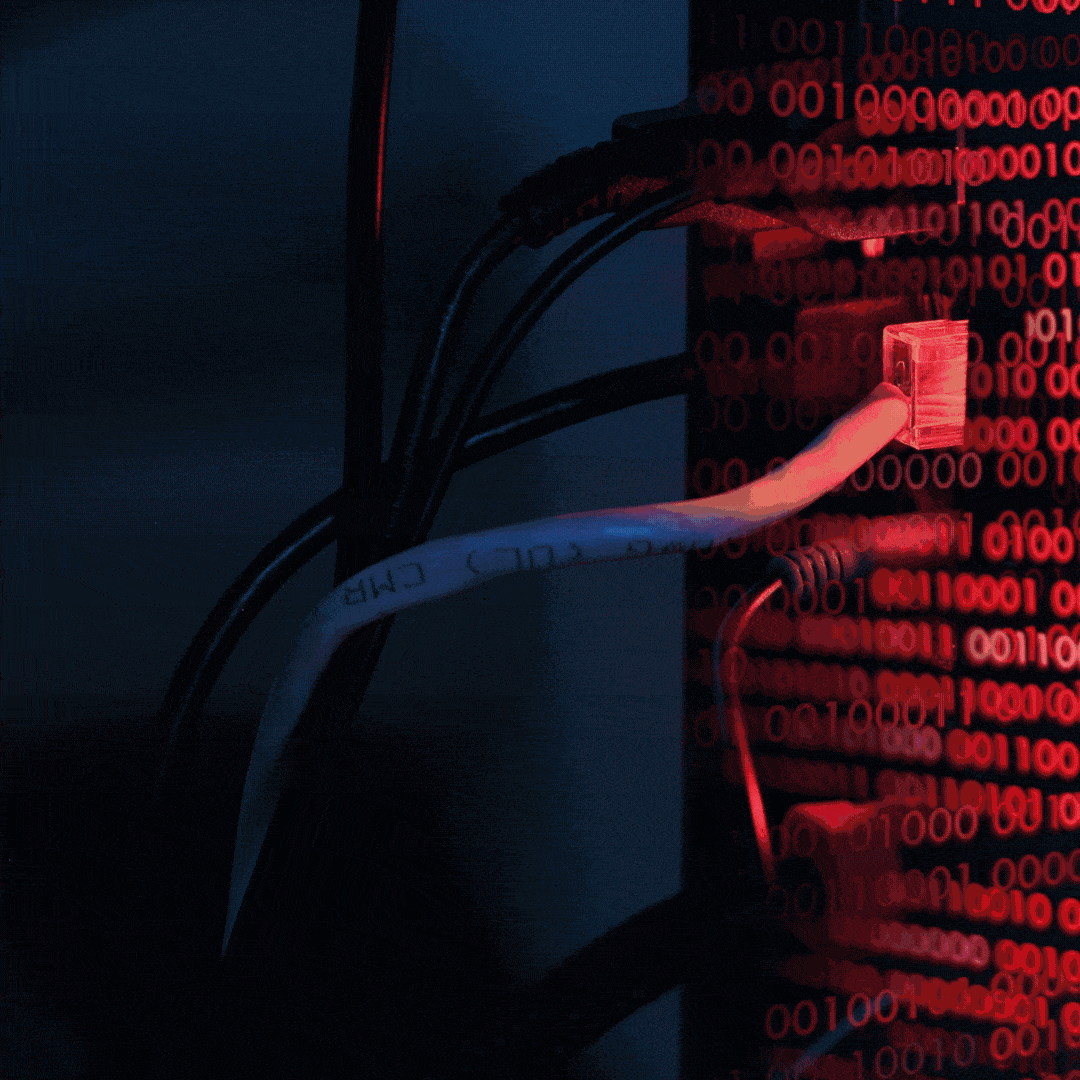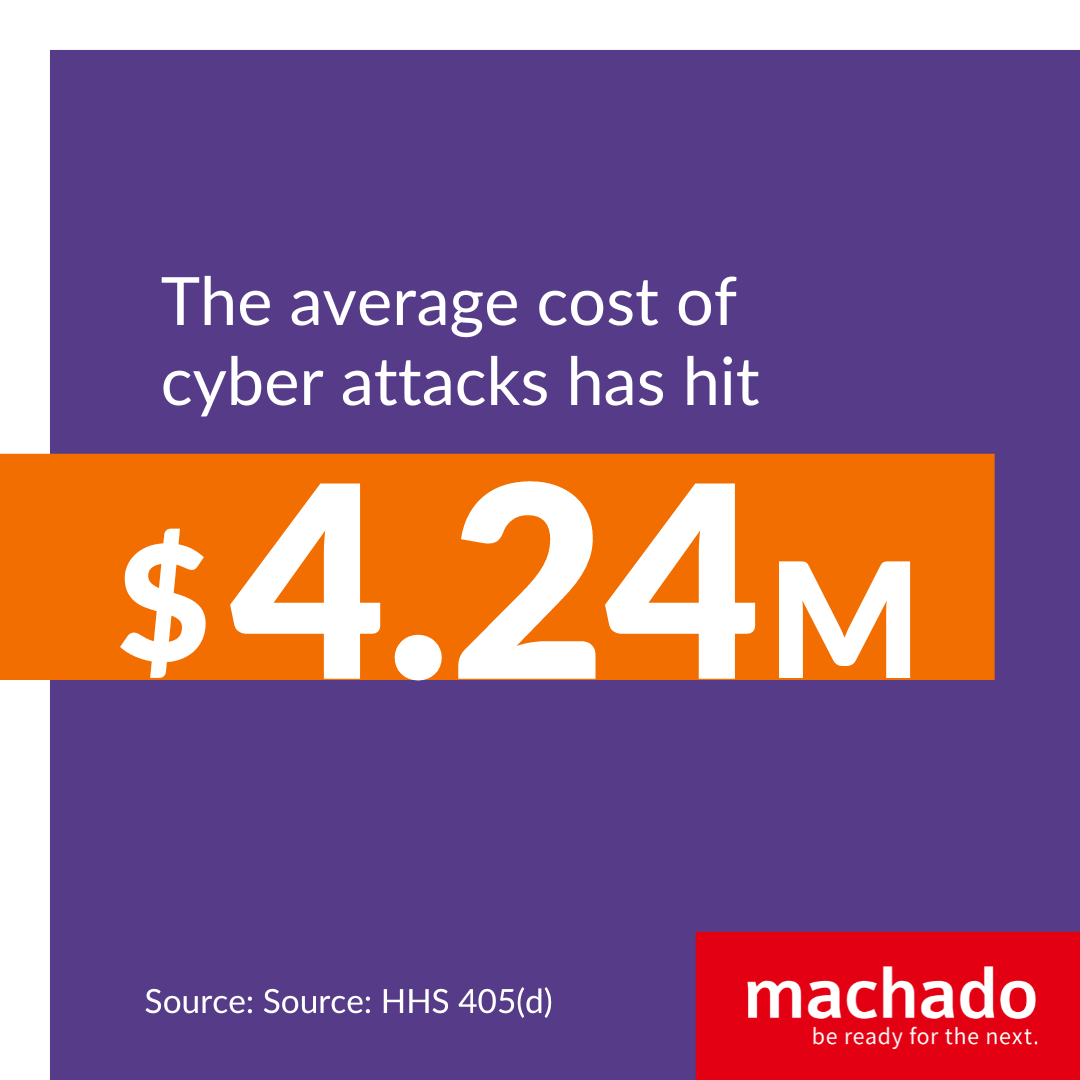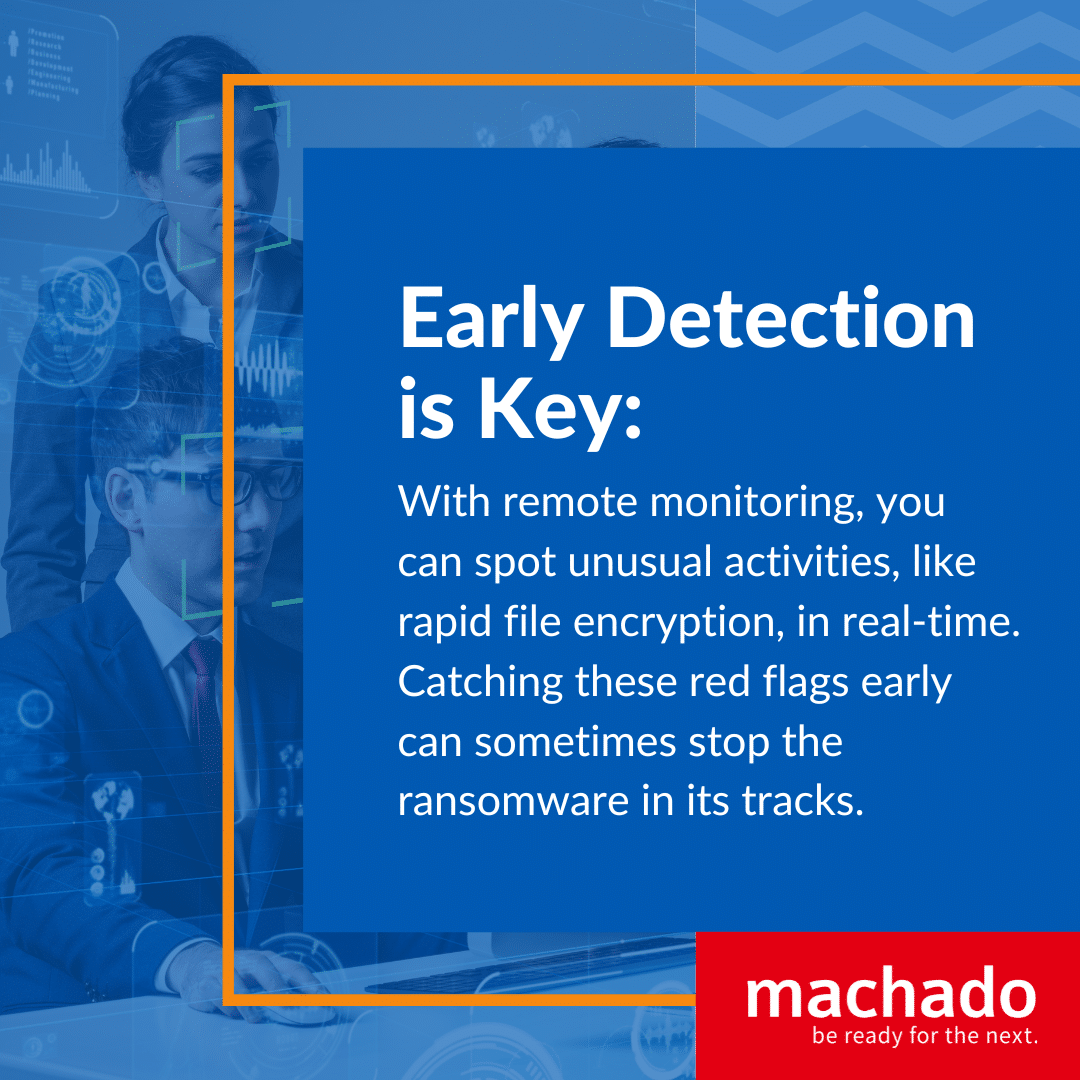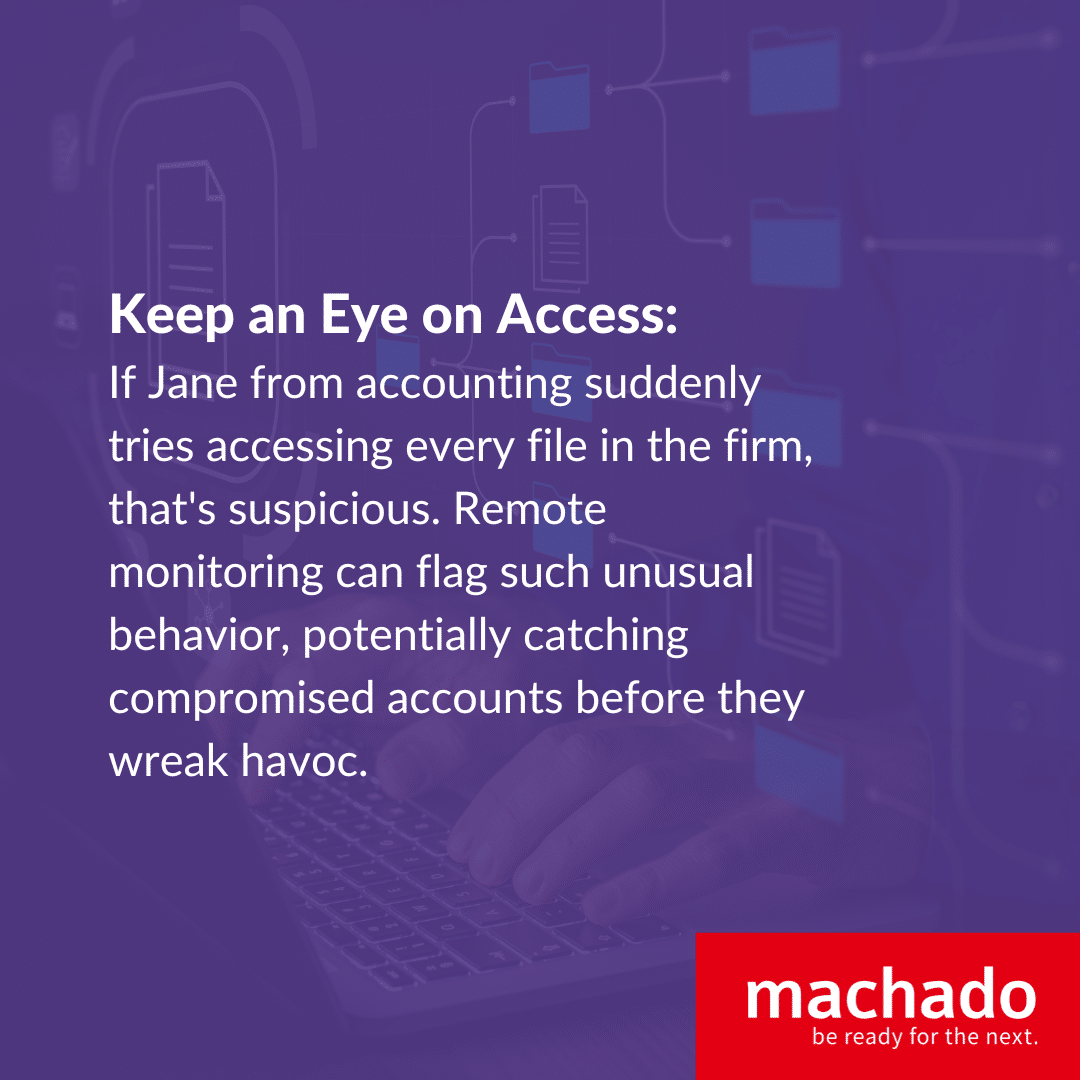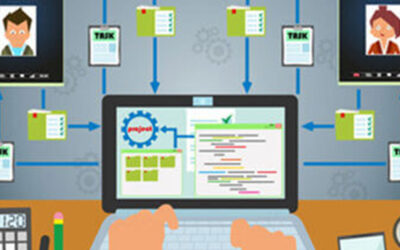TL;DR: With cybersecurity attacks becoming more prevalent every year it is important to protect not only your data, but the data of your firm. Remote Monitoring is able to do this for you, by employing IT Specialists you’re sure that your firm is better protected from cyber breaches, data loss, compliance failures, system downtime, all while eliminating the worries of your IT defense becoming obsolete.
Imagine this: It’s a Monday morning, and you’re ready to tackle the week ahead.
You power up your computer, only to find out that your law firm’s sensitive client data has been compromised.
The panic sets in.
How did this happen?
Who’s responsible?
And more importantly, how will this impact your firm’s reputation and your clients’ trust?
It’s a scenario no law firm wants to face. Yet cyber threats are not just a possibility—they’re a reality. From ransomware attacks to phishing scams, law firms are increasingly becoming lucrative targets for cybercriminals.
The stakes are high.
A single breach can lead to financial losses, damaged reputations, and legal repercussions.
And with the intricacies of legal data, the consequences can be even more severe.
But here’s the good news: there’s a way to stay ahead of these threats. Remote monitoring, a proactive approach to cybersecurity, can be the hero your law firm needs. By continuously scanning and monitoring your systems, it can detect and address vulnerabilities before they become a full-blown crisis.
In this post, we’ll explore the five most common threats that law firms face and explore how remote monitoring can be the game-changer in your cybersecurity strategy.
So, let’s get started and ensure that your firm is fortified against the ever-evolving world of cyber threats.
Threat #1: Data Breaches
Imagine your law firm’s legal software suite as a digital vault. This safe holds valuables like sensitive case details, eDiscovery tools, and your legal research database, each playing a critical role in the daily operations of your firm.
But just as a vault can attract the attention of a thief, your legal software can become a target for cybercriminals.
These digital marauders use a variety of tactics — malware, ransomware, phishing — to infiltrate your systems.
Their goal?
To exploit vulnerabilities in your software, gaining unauthorized access to sensitive information and disrupting your firm’s operations. The consequences can range from the exposure of confidential client data to a full-blown disruption of your case management processes, impacting your firm’s reputation and reliability.
These damages can average millions of dollars, with one report citing that the average cost of cyber attacks has hit $4.24M, an amount that has risen nearly $424,000 since 2019.
How Remote Monitoring Helps
Enter remote monitoring — your digital security team.
Around the clock, this system surveys your IT systems, keeping an ever-watchful eye for any sign of unusual or suspicious activity. At the first hint of a potential breach, the system reacts, rapidly addressing the threat and shoring up any vulnerabilities.
In essence, remote monitoring adds a layer of resilience to your law firm’s cybersecurity defenses. By constantly monitoring and managing your digital toolbox, it safeguards your vital legal software, ensuring these tools are not just secure, but also running optimally, thereby enabling you to focus on what matters most — serving your clients.
Threat #2: Data Loss from Document Management Systems
Document Management Systems (DMS) have vital case documents, client details, and essential administrative data, these systems form the backbone of your firm’s operations. Yet, their digital nature renders them susceptible to various threats that can result in data loss, such as hardware failures, accidental deletions, or even the malicious intent of cyberattacks.
Picture a scenario where a server failure occurs or a critical file is accidentally deleted. The ripple effects of such incidents can be significant, impeding ongoing cases and jeopardizing client relationships. A successful cyberattack can lead to a data breach, posing serious legal and reputational implications for your firm.
How Remote Monitoring Helps
This is where remote monitoring proves its worth. As an organizing machine, it consistently oversees your DMS, implementing regular data backups and ensuring a swift disaster recovery plan is in place. This dual defense strategy not only helps in restoring lost data, and minimizing downtime, but it also ensures that your firm’s vital information is secure and recoverable.
Remote monitoring empowers your law firm to turn the tides on data loss threats, transforming potential setbacks into blips on your IT radar, and ensuring your firm’s operations continue seamlessly.
RMM saves an MSP money, while improving an MSPs ability to conduct business. All while benefiting your firm. With MSPs saving between 30 minutes to 4 hours per business day, it can add savings in operational costs for the MSP, as well as extracting additional value for your firm by optimizing the speed of the IT security.
Threat #3: Compliance Failures with Client Confidentiality
The trust that clients place in their law firm is sacred. It’s founded on the bedrock of confidentiality—an expectation that their personal data and sensitive case information will be treated with utmost respect and protection. honoring this trust requires not just ethics but also compliance with regulations such as CCPA and other regional data privacy laws.
However, compliance isn’t just about ticking boxes on a checklist—it’s an active, ongoing endeavor.
It involves maintaining secure communication platforms, from client portals to email systems, and ensuring no cracks emerge that could potentially jeopardize client confidentiality. A failure to do so could result in severe penalties, not to mention the potential damage to your firm’s reputation and client relationships.
How Remote Monitoring Helps
Remote monitoring serves as your firm’s digital compliance officer, constantly ensuring that communication platforms are secure, data is encrypted, and access is controlled. Through regular audits, it identifies potential security gaps and proactively addresses them. In doing so, remote monitoring aids in maintaining compliance, giving you peace of mind and helping to uphold the sacred trust between your firm and its clients.
Remote monitoring goes beyond simply guarding against threats—it also enables your firm to uphold its ethical obligations and regulatory commitments, reinforcing your client’s trust and maintaining your firm’s standing in the industry.
Threat #4: Downtime of Case Management Systems
Imagine the chaos if the central nervous system of a body suddenly went offline. It’s similar to what happens when your law firm’s case management system experiences downtime due to software glitches, hardware malfunctions, or network failures.
These systems are the nerve centers of legal operations, managing case timelines, task assignments, and resource allocations. Any disruption could send shockwaves throughout your firm, impacting client service and overall productivity.
Consider the repercussions of an unexpected server crash or a sudden network outage. Active cases could stall, critical deadlines might be missed, and your firm’s operational rhythm could be thrown off-balance. What’s more, such disruptions could erode client trust and confidence in your firm’s capabilities.
How Remote Monitoring Helps
Enter the superhero of this story: remote monitoring. It operates akin to a health monitoring system for your law firm’s IT infrastructure, performing regular checks and spotting potential issues before they escalate. In case of an impending hardware failure or a software glitch, it proactively initiates measures to avert system downtime.
By identifying and resolving these issues promptly, remote monitoring ensures the continuity of your case management systems, thereby preserving your firm’s operational rhythm. This, in turn, ensures that your client service remains consistent and uninterrupted, strengthening your firm’s reputation for reliability and resilience.
Threat #5: Ransomware Attacks
Let’s look at why ransomware is a significant concern for the legal industry and how you can shield your firm from this cyber menace.
Immediate Disruption: Imagine starting your day, coffee in hand, only to find all your files encrypted and a ransom note on your screen. Terrifying, right? Ransomware can bring your operations to a screeching halt, making it impossible to work on cases or communicate with clients.
The Costly Dilemma: Beyond the operational nightmare, there’s the financial sting. Cybercriminals demand a hefty sum to decrypt your files. And here’s the kicker: even if you decide to pay, there’s no guarantee you’ll get your data back. Plus, paying might just paint a target on your back for future attacks.
Trust Issues: Your clients trust you with their most confidential information. A ransomware attack can erode that trust in a heartbeat. After all, if you can’t protect your data, how can clients trust you with theirs?
The Nightmare of Data Loss: Some ransomware doesn’t just lock your data—it deletes it. If your backups are compromised too, you might be looking at a permanent loss. And we all know how vital those records are.
How Remote Monitoring Helps
Before you start panicking, there’s good news. With the right tools and strategies, you can fortify your firm against ransomware threats.
Early Detection is Key: With remote monitoring, you can spot unusual activities, like rapid file encryption, in real-time. Catching these red flags early can sometimes stop the ransomware in its tracks.
Backup, Backup, Backup: Regular backups are your best defense. And guess what? Remote monitoring ensures your backups are in tip-top shape. If disaster strikes, you can breathe easy knowing you can restore from a clean backup.
Stay Updated: Many ransomware attacks prey on outdated software. Remote monitoring ensures all your systems are up-to-date, sealing off potential entry points for cybercriminals.
Keep an Eye on Access: If Jane from accounting suddenly tries accessing every file in the firm, that’s suspicious. Remote monitoring can flag such unusual behavior, potentially catching compromised accounts before they wreak havoc.
Divide and Conquer: Proper network segmentation ensures that if one part of your network gets hit, the ransomware doesn’t spread like wildfire. Monitoring tools can help maintain this segmentation, adding an extra layer of protection.
Ransomware is undeniably a looming threat, but with proactive measures and the power of remote monitoring, your law firm can stand strong against cybercriminals. Stay vigilant, keep your systems monitored, and always have a backup plan (literally!).
The Benefits of Using IT support for Law Firms
By understanding the vulnerabilities within your firm, you can proactively address them and minimize the risks posed by malicious actors.
Regular patching, updates, employee education and awareness, proactive endpoint monitoring, data backup, recovery, and security incident response all go hand in hand in strengthening your firm’s cybersecurity.
By adopting a multi-layered defense approach and incorporating these components, you can strengthen your endpoint security and reduce the chances of successful cyberattacks.
The significance of adaptation, proactive monitoring, collaboration, and exploring emerging technologies will enhance the ability for your firm to navigate IT proactively.
By staying informed, sharing information, and leveraging advanced technologies, organizations can stay ahead of emerging threats and enhance your endpoint security capabilities.
Endpoint security requires a proactive and comprehensive approach that addresses the vulnerabilities associated with unsecured endpoints, adapts to the evolving threats, and implements best practices and advanced technologies.
Let us build your IT confidence, with Machado Consulting’s proactive IT management, and Database Management. Your clients data is safe and secure. Instilling faith in you, and your firm. Contact us today and let us see how we can help.
Be Ready for the Next IT Opportunity
Download our guide to learn how you can get more done with your current IT staff.
Be Ready for the Next IT Opportunity
Download our guide to learn how you can get more done with your current IT staff.

